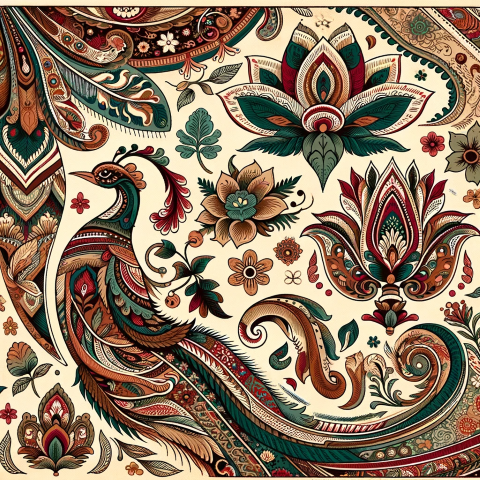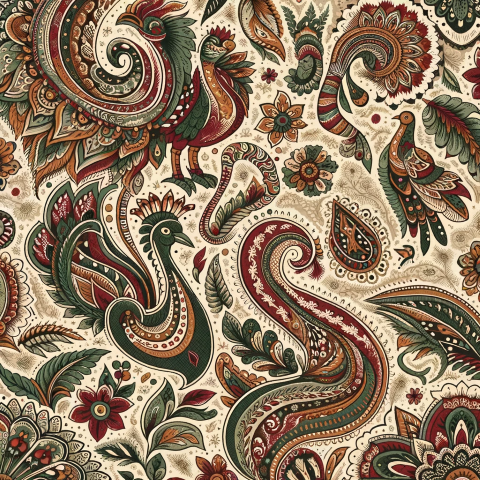Last Updated on: 27-May-2024 (2 months ago)
Share on Facebook • Share on Twitter
Kalamkari is a unique form of textile art that requires a great deal of skill and patience. The process of creating Kalamkari fabrics involves several stages, each of which requires a different set of skills and techniques. The first step is to prepare the fabric, which is typically made from cotton or silk. The fabric is then washed and bleached to remove any impurities or sizing, and is left to dry in the sun.
Once the fabric is ready, the next step is to create the design. This is done by using a kalam or pen, which is made from bamboo or date palm. The pen is dipped in a solution made from tamarind seed powder and water, and is used to draw the design onto the fabric. The designs are often inspired by nature, and feature motifs such as flowers, leaves, birds, and animals.
After the design is complete, the next step is to apply natural dyes to the fabric. The dyes used in Kalamkari are made from natural ingredients such as indigo, madder, pomegranate, and myrobalan. The dyes are mixed with water and applied to the fabric using a brush or block printing technique. The fabric is then left to dry in the sun.
Once the fabric has been dyed, the next step is to apply the finishing touches. This involves adding intricate details and patterns to the design using a fine brush or pen. The details are often created using a combination of different colors and shades, and can take several hours or even days to complete.
There are two main types of Kalamkari: Srikalahasti style and Machilipatnam style. The Srikalahasti style is characterized by bold and bright colors, and features intricate patterns and designs. The Machilipatnam style, on the other hand, is known for its delicate and intricate designs, and features more subtle colors.
Kalamkari is not just a textile art form, but is also an important part of India's cultural heritage. It is often used to create traditional garments such as saris, dupattas, and kurtas, as well as home decor items such as wall hangings, tablecloths, and cushion covers. Kalamkari fabrics are prized for their beauty, durability, and unique character, and are often passed down from generation to generation as family heirlooms.
In recent years, Kalamkari has gained popularity outside of India as well, and is now being used by designers and artists around the world to create unique and beautiful textiles. Kalamkari fabrics are often featured in high-end fashion shows and exhibitions, and are also available for purchase online and in specialty stores.
However, despite its popularity, Kalamkari is facing several challenges. The art form requires a great deal of skill and patience, and is often passed down through generations of families. However, as younger generations turn away from traditional arts and crafts in favor of modern technology and other forms of entertainment, the future of Kalamkari is uncertain.
Additionally, the use of chemical dyes and synthetic fabrics has made it more difficult to produce authentic Kalamkari fabrics. In response, there has been a growing movement to promote the use of natural dyes and organic fabrics, which helps to preserve the traditional techniques of Kalamkari.
Use of Kalam (or pen) inpatterning the fabrics through the medium of vegetable dyes that this term Kalamkaribecame widely known later as a trade term. Isused fordecorative or functional hangings,aswrapping andcovering material or incostume.
Some more terms:
Mackinaw
Historically, it was made from an ordinary grade of wool that often had shoddy re-used or remanufactured wool mixed in. A twill weave where the weave is concealed. Mackinaw is heavily fulled or...
Read about MackinawSPF
(Sun Protection Factor) SPF measures the effectiveness of sunscreen on the body. the test for SPF is done by using a living organism or body to measure the length of time it takes for the skin to...
Read about SPFNankeen
Nankeen, in the context of textiles, refers to a type of durable, plain-woven cotton fabric that originated in China. It is characterized by its distinctive pale yellow or off-white color, which is...
Read about NankeenWeight of Cloth
There are three ways by which fabric is sold. 1. Ounces per linear yard: a 14-ounce covert topcoating, a 22-ounce melton overcoating. 2. Yards to the pound: a 3. 60 airplane cloth, a 4. 00 filling...
Read about Weight of ClothPelmet
Decorative strip above window: a narrow piece of fabric or board attached above a window for decoration and to hide the curtain rod. Early 20th century. Probably alteration of French palmette...
Read about PelmetTow Fibers Revealed: The Power of Long, Continuous Strands
Tow is a term used to describe a type of textile fiber that is characterized by its long, continuous strands. Typically, tow fibers are produced from a variety of natural or synthetic materials and...
Read about TowHigh Loft
High loft is a term used in textiles to describe a type of fabric or batting that is characterized by its thickness and insulating properties. It is commonly used in products such as bedding,...
Read about High LoftFabric Face: The Textile's Tale Told on the Surface
That side of a fabric, which is intended to be shown by reason of weave or finish, presents a better appearance. In many fabrics, especially industrial ones there are no distinction between face and...
Read about FaceAdd a definition
- The term you want to define
- Its definition in 500 words or less
- Attach an image if necessary.
- Optionally, tell us about yourself in 200 words or less!
Companies for Kalamkari:
- Company name
- Company address
- Attach a logo, if necessary.
- Optionally, tell us about yourself in 200 words or less!

 Florence, in Tuscany, has a long history of textile production, dating back to the Renaissance.
Florence, in Tuscany, has a long history of textile production, dating back to the Renaissance.

